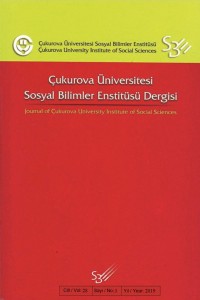SÜRDÜRÜLEBİLİR YÖNETİŞİM GÖSTERGELERİ: TÜRKİYE VE AVRUPA BİRLİĞİ ÜLKELERİ İÇİN ÇOK BOYUTLU ÖLÇEKLEME ANALİZİ
Abstract
Sürdürülebilir
yönetişim göstergeleri, ülkelerin mevcut sosyal ve politik zorluklara yanıt
verme yeteneğini değerlendiren ve hükümet faaliyetleri ile ilgili kapsamlı veri
havuzu sunan bir projedir. Bu çalışmada, 2014-2018 yılları arasındaki
sürdürülebilir yönetişim göstergeleri verileri ile, Avrupa Birliği üyesi
ülkeleri ve Türkiye’nin çok boyutlu ölçekleme analizi kullanılarak konumlarının
tespit edilmesi amaçlanmaktadır. Hem klasik hem de modern yöntemin uygulandığı
bu analizin sonucunda, Türkiye, Malta, Macaristan, İtalya, İspanya ve Polonya
gibi ülkeler ile “ikinci en kötü” grup içinde
yer alırken, Slovakya, Slovenya, Portekiz, Hırvatistan, Yunanistan ve GKRY “birinci en kötü” grupta yer almaktadır.
Buna karşılık, Lüksemburg, Birleşik Krallık, Finlandiya, Danimarka, Belçika,
Avusturya, Hollanda “ikinci en iyi” grup içinde yer alırken, Fransa, Irlanda,
Litvanya, Letonya, Almanya, Estonya “birinci
en iyi” grupta yer almaktadır. Buna ek olarak, Bulgaristan, Romanya, Çekya
ve İsveç ise modern ve klasik yöntemdeki sonuçlar karşılaştırıldığında,
uygulanan metodoloji nedeniyle farklı gruplarda yer almaktadır.
References
- Borg, I., & Groenen, P.J.F. (2005). Modern Multidimensional Scaling Theory And Applications. 2nd Edition, Springer, New York.
- Holling, C. S. (1978). Adaptive Environmental Assessment and Management. Chichester, UK: John Wiley and Sons.
- Holling, C. S., & Gunderson L. H. (2002). Resilience and Adaptive Cycles, L. H. Gunderson & C. S. Holling (Eds.). Panarchy: Understanding Transformations İn Human And Natural Systems. Island Press, Washington, D.C., USA, 25-62.
- Kooiman, J. (1999). Social-Political Governance: Overview, Reflections and Design. Public Management Review, 1 (1), 67–92.
- Kruskal, J. B. (1964). Nonmetric Multidimensional Scaling: A Numerical Method. Psychometrika, 29, 115–129.
- Geels, F. (2005). Technological Transitions and System Innovations: A Co-evoluationary and Socio-Technical Analysis. Cheltenham: Edward Elgar.
- Meadowcroft, J. (2000). Sustainable Development: A New(ish) Idea for a New Century?. Political Studies, 48, 2, 03-222.
- Meadowcroft, J. (2005). From Welfare State To Ecostate?. J. Barry & R. Eckersley (Eds.). The State and The Global Ecological Crisis. Cambridge, MA: MIT Press, 3–23.
- Meadowcroft, J. (2013). Sustainable Development. M. Bevir (Eds.), The Sage Handbook of Governance, London, 535–551.
- Report of the World Commission on Environment and Development: Our Common Future, WCED, https://sustainabledevelopment.un.org/content/documents/5987our-common-future.pdf, Erişim Tarihi: 15.11.2019.
- Rotmans, J., Kemp,R. & Van Asselt M. (2001). More Evolution than Revolution. Transition Management in Public Policy. Foresight, 3(1), 15-31.
- Shepard, R. N. (1962). The Analysis of Proximities: Multidimensional Scaling With An Unknown Distance Function. I. Psychometrika. 27(2), 125–140.
- Sustanability Governance Indicators (2019), https://www.sgi-network.org/2019/, Erişim Tarihi: 15.11.2019.
- Sustanability Governance Indicators Codebook (2018), https://www.sgi-network.org/docs/2018/basics/SGI2018_Codebook.pdf, Erişim Tarihi: 15.11.2019.
- Tischler D. & Seelkopf L. (2015). Concept and Methodology – Sustainable Governance Indicators 2015. Bertelsmann Stiftung.
- Torgerson, W. S. (1952). Multidimensional scaling: Theory and Method. Psychometrika. December, 17(4), 401–419.
- Walker, B. H., Gunderson, L. H., Kinzig, A. P., Folke, C., Carpenter, S. R. & L. Schultz (2006). A Handful Of Heuristics And Some Propositions For Understanding Resilience İn Social-Ecological Systems. Ecology and Society, 11(1):13.
- Van der Brugge R. & Van Raak R. (2007). Facing The Adaptive Management Challenge: İnsights From Transition Management. Ecology and Society. 2007;12(2):33.
- Mardia, K. V., Kent, J. T., & Bibby, J. M. (1979). Multivariate Analysis Academic Press Inc. London, LTD.
- Gunderson, L.H., Holling, C.S. (2002). Panarchy: Understanding Transformations in Human and Natural Systems. Washington D.C.: Island Press.
Details
| Primary Language | Turkish |
|---|---|
| Journal Section | Articles |
| Authors | |
| Publication Date | December 15, 2019 |
| Submission Date | November 19, 2019 |
| Published in Issue | Year 2019 Volume: 28 Issue: 3 |

